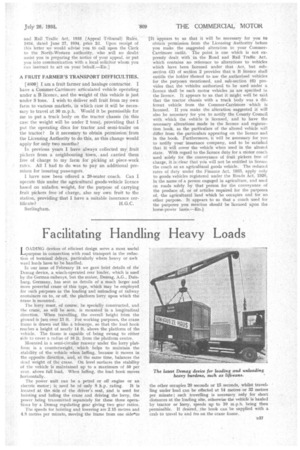Facilitating Handling Heavy Loads
Page 55

If you've noticed an error in this article please click here to report it so we can fix it.
LOADING devices of efficient design serve a most useful purpose in connection with road transport in the reduction of terminal delays, particularly where heavy or awk ward loads have to he handled.
In our issue of February 15 we gave brief details of tht Dentag device, a winch-operated rear loader, which is used by the German railways, but the maker, Dernag,'A.G., Duisburg, Germany, has sent us details of a much larger and More powerful crane Of this type, which may he employed for such purposes as the loading and unloading of railway containers on to, or off, the platform lorry upon which the Crane is mounted.
The lorry must, of course, be specially constructed, and the crane, as will be seen, is mounted in a longitudinal direction. When travelling, the overall height frbm the ground is just over 13 ft. For working purposes, the crane frame is drawn out like a telescope, so that the load hook reaches a height of nearly 14 ft. above the platform of the vehicle. The frame is capable of being swung to either side to cover a radius of 10 ft. from the platform centre.
Mounted in a semi-circular runway under the lorry platform is a counterweight, which helps to maintain the stability of the vehicle when luffing, because it moves in the opposite direction, and; at the same time, balances the dead weight of the crane. On level surfaces the stability of the vehicle is maintained up to a maximum of 50 per cent, above full load_ When lulling, the load hook moves horizontally.
The power unit can be a petrol or oil engine or an
electric motor; it need he of only 8 hp. rating. It is located at the side of the driver's seat, and is used for hoisting and buffing the crane and driving the lorry, the power being transmitted separately for these three operations by a Demagregulating gear giving two gear ratios.
The speeds for hoisting and lowering are 2,15 metres and 4.3 metres per minute, moving the frame from one sideto the other occupies 20 seconds or 15 seconds, whilst travelling under load can be effected at 14 metres or 32 metres per minute ; such travelling is necessary only for short distances at the loading site, otherwise the vehicle is hauled by tractor or lorry, speeds up to 10 m.p.h. being then permissible. If desired, the hook can be supplied with a crab to travel to and fro on the crane frame.




































































































